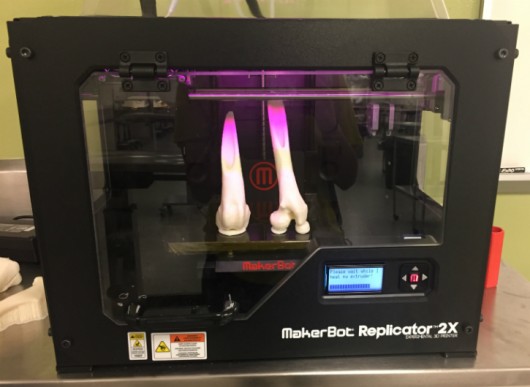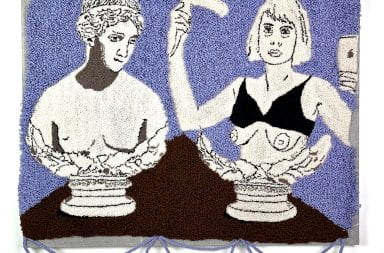
With input of a CT scan, the 3-D printer is able to create a plastic model within four hours. Credit: Rubina Kapil
Ohio State veterinary surgeons are now practicing their most complex surgeries days before actually conducting them.
The OSU College of Veterinary Medicine is the first veterinary college in the country to use 3-D printers, implementing them into research, education and surgical procedures, according to Dr. Tatiana Motta, an assistant professor at the college.
“Some of our client animals go through difficult orthopedic procedures involving major bone deformities,” Motta said. “They are very unique and reconstructive surgeries are very challenging.”
With the input of a CT scan from an animal, the 3-D printer prints a replica plastic bone within about four hours, giving the surgeon time to rehearse prior to the client’s appointment.
“Our experience has been a happy marriage of technology, outreach and surgical innovation to improve patient outcomes,” veterinarian surgeon Dr. Jonathan Dyce said. “As a surgeon, innovation is valuable if my patients walk sounder and stronger as a result.”
The printers are also aiding in furthering student education.
All veterinary students are required to go through hands-on surgical training, a process that now utilizes plastic bones to minimize animal use.
“With the 3-D printer, plastic bones that are perfect replicas from our canine companion animals are printed to each student and they have the opportunity to repair bone fractures during their training,” Motta said.

All animal patients with unique or challenging disfigurement are given the option to allow their CT scans to become a 3-D model for research and education purposes. Credit: Rubina Kapil
College of Veterinary Medicine student Sarah Leyman worked with the bones in her third-year surgical lab to practice various types of surgical fixation commonly used for dog leg fractures.
Leyman said she sees endless possibilities after working with the plastic bones in her third-year surgical lab.
“The printer is a perfect example of how to apply the One Health concept. That is, the unity of human, animal and environmental health,” Leyman said. “We can learn, as students, about lessening the burden on animal models needed for teaching and veterinarians can take more chances with therapies, which could one day be translated into human medicine.”
Several students also work with Motta on a surgical simulation program, learning and mastering the process of printing three dimensional bones from CT scans of canine patients.
“Education is a top priority for our college as well as OSU, and this printer is one more tool to ensure we are preparing future veterinarians to deliver the best possible care for our animals,” Motta said.
The college currently has two printers in-house, and may buy more in the future, according to Dr. Motta.
“To date, we have only scratched the surface of this emerging medical field,” Dr. Dyce said.


